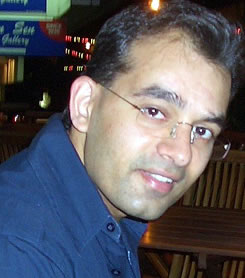The name is Shroff... Shravan Shroff. Claim to fame: Fame Adlabs. Armed with an MBA degree, this alumnus of Melbourne Business School, Australia came back to Mumbai to introduce the concept of modern and plush cinema halls in Mumbai.
As of now, he is all set to spread the multiplex web across the country. His vision is to institutionalise the film trade business; gear up to produce, distribute and exhibit films under the same banner.
All of 34 years, Shroff is an entrepreneur to look out for. And to think he wasn't even keen on the cinema business. But something about the industry triggered off the business man in him and he embarked on to the journey to bring about some order in this highly disorganised business.
Although he is proud to be his father's son, he is loathe to the idea of being identified by it. It is quite something to watch this soft spoken guy gets transformed into a hard as a knuckles business man. In a tete-e-tete with indiantelevision.com's Trupti Ghag he talks about his journey, his achievements and his ambitions.
Excerpts:
|
Was it always assumed that you would be joining the business? I remember reading that you were keen on becoming a pilot... Honestly, when I was in school I thought I would join the business. Though I wan't a 'filmy kid', I was keen on the trade aspect. I was clued on to the trade magazines that dad got home. I did join the family business during my college days. The first film that I actually worked on was 1942 - A love story. The movie was released in 1994 and it was distributed by us. But the movie, despite a great story line, didn't do too well. During the same time - Hum Aapke Hai Kaun - a Rajshri movie - did really well. I was pretty disillusioned. But I took that opportunity to think more about it. I then decided that I need to study more and get more experience. I was just a BCom graduate, so I went abroad to study. |
||
|
How was the experience? Was it helpful? Unfortunately, people in the film industry here don't value time. And after Australia, I realised that I couldn't work like that. |
||
|
But I understand that after coming back to India, you weren't quite keen to join the business? But after some time, I noticed that there is an opportunity. I still had to figure out where it was. What I was clear about was that I did not want to be known as my father's son. |
||
|
And where exactly did you find that opportunity? While I was tinkering away, I thought that I should do something similar for Shringar. So I did a case study for Shringar in 1996, and bingo! It made a lot of sense, for my business, to do either production or exhibition. So I sent an e-mail to dad and he said that it was great and I needed to come back to India if I was serious about implementing it. I started to experiment with production, but it was a culture shock for me. Owing to my father's name it was easy for me to meet people, producers directors but I didn't like what I saw. Being an organised person, I felt a complete misfit. I quickly realised that I can't do production and I didn't want to do distribution. It would have been foolish to chuck the family business away because of the kick start I had. By that logic, I had to start looking at exhibition. I knew that there is a gap in the market. Also what was helpful was a small stint at a multiplex company in Australia. So, I started developing the exhibition business. |
||
|
And how exactly did you go ahead with it? I readied a business plan and approached my dad for money. The capital investment was to be done by the owner and all that I had to do was to pay the weekly rent and deposit Rs 5 million. Although dad gave me the cheque, he told me 'son you can either blow this money and I can afford it or you can make this Rs 5 million into Rs 50 million. The choice is yours. I just hope that you won't squander the money.' I had it my head that I needed to repay it back and with a good return. |
||
|
Then what? If it had been super flop, people would have called me an idiot. If I had succeeded they would have said 'with his connections and education it was just so easy'. So I really had to do it for myself. |
||
|
||
|
How did the multiplex business come about? I spoke to my dad about it. He said that it was a great idea. So I asked him for another loan of Rs 50 million. He was shocked but he agreed to give me Rs 25 million and the rest I had to arrange on my own. So I contacted Adlabs and took them through the entire proposal. They agreed to invest another Rs 25 million but their mandate was clear: 'We will only invest, you have to run the business'. The cost of the project was Rs 150-160 millions, so I decided to raise rest of the money through debt. But that was easier said than done as no bank was ready to give that kind of money to a multiplex. I managed to get Rs 95 million from IDBI bank. That was after I spent about nine to 10 months pursuing them. Later, a venture capitalist showed interest and by 2001, we had raised Rs 180 million, which I think was my biggest achievement. I was able to raise organised capital in the country. Once the organised capital came in, I could instal the system, employ people and hire processes. We got better auditors and hired professionals. Once the ball started rolling things were a bit easier. The industry got recognised. Fame Adlabs started working, and we did well. We organised the distribution business. We opened up local operations in Ahmedabad, Delhi and Madras. |
||
|
Instead of starting off something completely new, why didn't you think about growing the distribution business further? Weren't the stakes higher? Unfortunately for us, last year, a couple of my properties, which were supposed to come up, got delayed. But this year is a big year for us. We have five properties, which include In Orbit in Malad, a four screen project with a mall - Raghuleela in Kandivili, and another four screen project in Kolkata. We will be inaugurating a six screen multiplex in Surat in July and another three screen one in Nasik in November. We plan to open up four-six properties every year in the next four years. |
||
|
You had announced plans to open up multiplexes in Bangalore and Ahmedabad? What about that? Another six screen project in Kolkata is in the pipeline along with a four screen one in Pune. Almost 100 per cent of my time is spent in the exhibition business. I am constantly negotiating for new properties |
||
|
Could you explain to me what Shringar is all about? The operations started of as film financiers and then you branched off into distribution? What is the structure of the company like? The mandate of Shringar Films is distribution and the mandate of Shringar Cinema is to run multiplexes, single screen and to do programming of theatre. In future, if we do production we will either do it under the Shringar Films banner or shoot off another company. But we don't want to get into production for the next two years because we have too much on our plate. Our future plan is to integrate a value chain. A good example of vertical chain integration is IMAX Adlabs, which is into processing, distribution and exhibition. Rajshri is another good example which is into production, distribution and now into exhibition. |
||
|
Something like a Studio Model? |
||
|
Is film distribution an organised industry? |
||
|
What is the logistics of the multiples business? Is the audience base growing? How is the competition with the small screens? Do single screens have chance to survive? I would compare multiplexes to five star hotels and single screen to three-two star hotel. There is room for everyone. Just like the automobile business where you have a Honda Accord doing equally good business as Maruti Alto. There is a buyer for everything provided the product is good. As for single theaters, some of them are so badly maintained that consumers don't want to go there. What they have to realise is that they are placed in fabulous locations, unlike multiplexes, which are far-flung. If the single screen owners decide to upgrade their theater, for say about Rs 10-15 millions, and work out a decent offering they can give the multiplex owners a run for their money. What they don't realise is that multiplexes have invested Rs 150-160 million, so they are in no position of taking heavy cuts in their profit. But what the single screens have to realise is that the day we finish with the multiplex business were going to go after the single screen business. We, at Shringar, are already planning to rent out the single screens, refurbish and run them. If you come up with a quality product, which is priced less, people are going to make a run for it. |
||
|
How has the Fame Adlabs fared in the last three years? |
||
| And what happened after you had competition right across the road? Initially, we were apprehensive about competition coming right across the road. But interestingly, Fun Republic has grown the market. We used to clock about Rs 1.7-1.8 million per week and now we collectively get in about Rs 2.9 million per week. Fortunately we do eight to ten per cent more business than them. |
||
|
Isn't that due to first mover's advantage? |
||
|
What about your own mall? It isn't in such great shape either? A mall should be like our In-Orbit. We have 2000 car parking space, anchors, brands... |
||
|
But In-orbit is a high end product… |
||
|
||
|
What is the safety procedure at the theatre like? I realise that the entrance to Fame Adlabs is rather narrow… Every year, I have to renew my license and honestly corruption works only to move the file. It does not work to bend the rules. |
||
|
Does the government contribute towards the growth of multiplexes? |
||
|
According to you what is the roadblock in the growth of the exhibition business? |
||
|
What is the annual turnover at Shringar like? What turn over is the exhibition business targeting for the year ahead? |
||
|
What is the revenue pie at Shringar Cinemas like? |
||
|
But really how effective are in-theatre ads? Are the planners looking at it seriously? We as a multiplex company are now talking to the Nielsen guys. We are negotiation for a process to authenticate the data. It will happen this year. |
||
|
What do you look for in a product before taking it on board? For distribution that is.. |
||
|
Is there like a 60-40 formula that you incorporate? For example 60 per cent of the movies that you take on board are certified winners and 40 per cent are ones you believe will deliver... |
||
|
Would you ever get into television production? |








